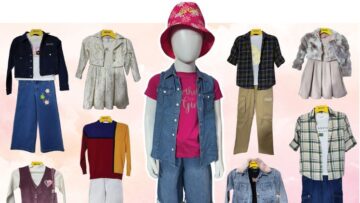
Garment manufacturing isn’t just about stitching fabric, it’s about putting together precision, efficiency, speed and a whole lot of creativity. That’s where VI.BE.MAC. and M.A.I.C.A. step in, redefining automation with cutting-edge sewing technology.
From denim-perfecting innovations to next-level shirt production solutions, these Italian powerhouses, backed by Jack, are transforming the RMG industry worldwide, particularly in Bangladesh.
“Although VI.BE.MAC. and M.A.I.C.A. operate as separate entities, we function as one cohesive team under Jack’s ownership. We share resources and collaborate on strategies while maintaining our independence in decision-making,” stated Andrea Tomaselli, GM, M.A.I.C.A.
He added, “Our shirt production machines continue to garner the most interest, reflecting the consistent demand for advanced solutions in this segment.”
Whereas, Mauro Marzioni, Sales Director, VI.BE.MAC. highlighted their strong presence in Bangladesh, holding about 20 per cent of the market, with even bigger growth ahead.
In an exclusive interview with Apparel Resources, the duo talked at length about how their innovative solutions are helping the RMG industry with improved efficiency and productivity.
AR: How did 2024 go for your global and Bangladesh markets?
Mauro Marzioni: Globally, the market faced challenges due to geopolitical conflicts in Eastern Europe and Israel, which disrupted the global economy. In Bangladesh, the situation was even more challenging as government shutdowns led to factory closures and buyers hesitated to place orders. Many shifted orders to other countries like Pakistan, though the impact was minimal. Despite these difficulties, there was a positive uptick in October and November, with data indicating a 15-20 per cent growth. However, August and September were notably weak for the market.
AR: What makes your new products stand out from competitors?
Mauro Marzioni: We focus on efficiency, cost reduction and innovation. By studying our competitors’ machines, we aim to deliver features that are either better or entirely unique.
A prime example is our patented V702 3-needle chain stitch automatic back pocket hemming unit, part of our V700 series of back pocket hemming machines. This versatile unit excels in both efficiency and quality, delivering high output with exceptional precision. The modular design allows for flexible integration and maximises space utilisation. When paired with the V070 loader, the V702 operates fully autonomously. This unit can process a wide range of fabric thicknesses, from robust workwear to delicate denim and stretch materials, thanks to its innovative transport system. The V702 can achieve an average output of 1800 to 2000 pockets per hour.
Another standout machine is the VM02 pocket setter. Designed for speed and precision, the VM02 combines advanced automation with flexibility, allowing it to handle various pocket styles and sizes. Its innovative setup minimises fabric waste and reduces operator intervention, offering high productivity and consistent quality. The VM02 is particularly valued for its reliability and ability to integrate into existing production lines, helping manufacturers optimise their processes while lowering overall costs.
In Bangladesh, there is a high demand for advanced machines that enhance efficiency and precision in garment production. For VI.BE.MAC., models such as VM01 and VM02 Pocket Setters, V702 Pocket Hemming Machine, V4650 Belt Loop Setter and FOA units like VM03 and V263 are highly valued in denim manufacturing.
We are focused on expanding our footprint by building stronger customer relationships and enhancing our service and sales efforts. We have a full after-sales team in Bangladesh comprising local professionals, with additional support from Italian technicians when required.
| “Designed for speed and precision, the VM02 combines advanced automation with flexibility, allowing it to handle various pocket styles and sizes. Its innovative setup minimises fabric waste and reduces operator intervention, offering high productivity and consistent quality.” Mauro Marzioni Sales Director, VI.BE.MAC. |
AR: How are your products helping RMG players save energy and reduce waste? Can you share some examples?
Mauro Marzioni: Sustainability is one of our main priorities, reflecting the pressing environmental challenges of our time. Our commitment to sustainability is evident in our research and development processes, which focus on designing components and technologies that enable our machines to consume less energy during operation while minimising material waste throughout the sewing process.
For example, the VM02 Back pocket setter excels at reducing material waste, as it can operate with as little as 8 mm of excess fabric for pocket folding, ensuring precision and reducing errors. Similarly, the V4650EV9-UP3 Belt Loop Setter reduces material waste through its automatic cutting system, which ensures accurate loop lengths and efficient attachment.
Additionally, we are progressively implementing brushless motors across our machines to enhance energy efficiency. These motors consume significantly less energy compared to traditional motors, helping customers lower their power costs while maintaining high performance. This phased adoption reflects our ongoing commitment to sustainability and innovation.
| 8 MM
The VM02 Back pocket setter excels at reducing material waste, as it can operate with as little as 8 mm of excess fabric for pocket folding. |
AR: How is IoT shaping your machines and is the industry receptive towards it?
Mauro Marzioni: Around 90 per cent of our machines are already IoT-enabled, and for those that aren’t, we offer add-on devices to enable IoT. However, IoT adoption in Asia remains limited.
The reason being, for loT to work in the RMG industry, it’s not enough to just have machines with loT capabilities. Factories need a reliable internet connection, computer to collect and process the data and trained people to use the information effectively. Without these, the benefits of loT like better efficiency and reduced downtime, can’t be fully realised. In many cases, factories don’t yet have the infrastructure or resources needed, which is why adoption is still limited in some regions. However, as more factories invest in these areas, loT can make a big difference in production and performance.
| “The UAM03 Collar and Cuff Runstitch Machine is a fully automated system for stitching collars and cuffs, with a workspace that allows stitching, trimming and automatic unloading of the piece. It’s computer-controlled, enabling automatic changes in dimensions and stitching types, offering great versatility to different applications.” Andrea Tomaselli GM, M.A.I.C.A. |
AR: What is VI.BE.MAC.’s market share in Bangladesh?
Mauro Marzioni: It’s difficult to provide an exact figure, as we compete with numerous companies, including European and Chinese manufacturers. Globally, VI.BE.MAC. holds around 30 per cent of the market, but in 2024, our share in Bangladesh was approximately 20 per cent. This year, we aim to reclaim and possibly exceed that market share.
AR: You have factories in both China and Italy. How do the products from each one compare?
Mauro Marzioni: Both plants produce different categories of machines. The Chinese plant focuses on cost-effective production, catering to price-sensitive markets like Bangladesh, India and Pakistan. Italian machines, on the other hand, prioritise durability, quality and advanced features. This distinction allows us to serve diverse market needs effectively.
AR: How is M.A.I.C.A. automating production while reducing waste?
Andrea Tomaselli: Our solutions cater to a wide range of RMG products, including vests, T-shirts, trousers and shirts. For shirts, we provide automatedsystems for sleeve plackets, buttonholes, button attaching, collar and cuff stitching and run stitches.
For instance, one of the latest innovations at M.A.I.C.A. is the UAM01 Pocket Setter, an automatic machine designed to apply pockets without the need for pre-ironing. Thanks to a cold-folding system, it ensures precise positioning and perfect folding of the pocket before stitching. It’s highly flexible, allowing the stitching of pockets with flaps and adapting to production of various sizes.
Next up, we have got the UAM03 Collar and Cuff Runstitch Machine. It’s a fully automated system for stitching collars and cuffs, with a workspace that allows stitching, trimming and automatic unloading of the piece. It’s computer-controlled, enabling automatic changes in dimensions and stitching types, offering great versatility to different applications.
Then there is UAM04 Sleeve Placket Setter. This one is designed to fold and stitch the sleeve placket without the need for pre-ironing. It’s equipped with patented folding heads that work simultaneously on the right and left sides, with a laser and suction system for precise alignment, making it ideal for high-quality shirt sleeves.
Whereas, the UAM05 Cuff Topstitch Machine is an advanced solution to reduce cuff production times, capable of stitching different cuff shapes. With an automatic loading and unloading system, it operates without constant operator presence, increasing efficiency.
All of these machines meet the growing demand for precision and automation in shirt production, optimising operational efficiency and ensuring consistent quality.
We are also particular about sustainability. As explained, our machines are designed with advanced automation features that streamline production processes, decreasing errors and rework, which in turn help to cut down material waste.
No wonder, Bangladesh emerged as a strong market for us last year, contributing 20-25 per cent of our turnover. However, sustaining such growth is challenging. We remain optimistic and are working to meet or exceed those figures this year.
AR: Since cost can be a challenge for some players, how do VI.BE.MAC. and M.A.I.C.A. help customers understand the long-term value and return on investment of their high-end machines?
Andrea Tomaselli and Mauro Marzioni: We agree the main challenge is the cost aspect, but our machines can handle all types of fabrics and materials, with no significant technical limitations. Moreover, the manufacturers are fully aware that the long-term value and return on investment of our ‘Made in Italy’ machines are based on their reliability and durability, which significantly reduce operational costs over time.






